Opportunity Youth: Disenfranchised Young People
Opportunity Youth: Disenfranchised Young People
Opportunity Youth: Disenfranchised Young People
You also want an ePaper? Increase the reach of your titles
YUMPU automatically turns print PDFs into web optimized ePapers that Google loves.
Disconnected <strong>Youth</strong>: A Look at 16 to 24 Year Olds Who Are Not Working or In School<br />
Figure 13. Rates of Disconnected Females Ages 16-24, by Age Group, 2014<br />
Source: Congressional Research Service based on analysis of data from the U.S. Census Bureau 1988 through<br />
2014 Current Population Survey (CPS) Annual Social and Economic Supplement (ASEC).<br />
Notes: Disconnected youth are youth who were not working or in school at the time of the survey and were<br />
reported as having not worked during the previous year for reasons other than going to school.<br />
Race, Ethnicity, and Sex<br />
As shown in Table 1, earlier, minorities are overrepresented among the disconnected youth<br />
population. Perhaps most striking is the percentage of black (non-Hispanic) males who are<br />
disconnected relative to their white (non-Hispanic) and Hispanic counterparts (see Figure 14).<br />
Over the period depicted, the disconnected rate for black males averaged 6.6 percentage points<br />
above that of their white non-Hispanic counterparts, and 4.7 percentage points above that of<br />
Hispanic males. The gap was largest in 2003 when the disconnection rate of black males reached<br />
a historic high of 12.4%, which was 9.8 percentage points above their white counterparts (2.6%),<br />
and 8.9 percentage points above that of male Hispanic youth (3.5%). In that year, black males<br />
were nearly five times more likely to be disconnected than white males, and three and one-half<br />
times more likely than Hispanic males. Black male youth experienced a drop in their<br />
disconnection rate, with the rate being nearly cut in half, from 12.4% in 2003 to 6.8% in 2008.<br />
The rate of disconnection increased again in 2009 and 2010—and then generally increased over<br />
the period from 2011 through 2014, when the rate of disconnection for black males was 13.1%.<br />
This is in contrast to Hispanic and white males whose rates of disconnection decreased in most<br />
years over the 2010 through 2014 period. Notably, Hispanic and white males had nearly identical<br />
rates of disconnection at about 5.0% in both 2013 and 2014.<br />
Congressional Research Service 32

















